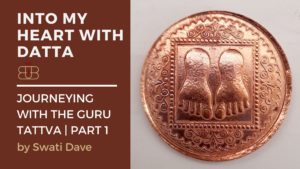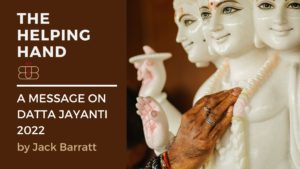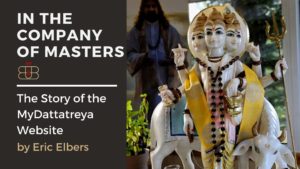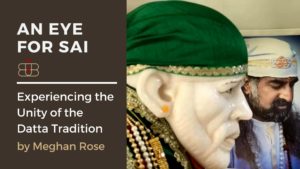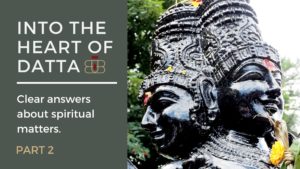Overview and Significance
Bhogar, Bhoganathar or Boyang was a Tamil Siddha (a being who has achieved spiritual perfection) who lived sometime between 5500 and 3000 B.C. Bhogar, coming from a goldsmith caste, was a South Indian by birth destined to become a Siddha Purusha under his Guru Kalanginathar. Bhogar’s Guru, Kalanginathar, was a being from China who attained to Siddhahood in South India and thus became included among the Eighteen Siddhas. Bhogar is also known as the Palanimalai Siddha.
Bhogar is believed to have lived before 3000 B.C. before the beginning of Kali Yuga and traveled widely in the Near and Far East. He is said to have been a rare mathematical prodigy and a diplomat of excellent caliber. Bhogar went from Tamil Nadu to China and taught about the path to Perfect Enlightenment (as mentioned in his book Bhogar 7000).
Bhogar was an expert in Siddha medicine, and it is said that as per the last wishes of his Guru, Bhogar proceeded to China to spread the knowledge of Siddha sciences. His journey is said to have been made with the aid of an aircraft; he demonstrated to the Chinese the details of the plane’s construction and later built a sea-going craft using a steam engine. The details of these and other experiments demonstrated by Bhogar in China are documented in the Saptakanda.
Lao Tzu – the founder of Taoism (5th century B.C.), was the first of the Chinese to propound the theory of duality of matter — the male Yang and female Yin — which conforms to the Siddha concept of Shiva-Shakti or positive-negative forces. This very same concept was first revealed by the Adi-Siddha Agastya Rishi, whose time period of operation is as old as the Vedas, conservatively dated at 3500 B.C.
Bhogar was skilled in Siddha medicine and, in consultation with the revered Agastya Muni (Father of Ayurvedic Medicine) and other Siddhas, used 4448 rare herbs to make nine poisonous medicines or Navapashanam (Nava means nine; Pashanam means poison). Out of this Navapashanam, he proceeded to make one Master Medicinal compound that could cure all diseases in a solid stone-like form as Lord Murugan (aka Skanda or Karthikeya), which is currently worshiped as the main deity in Palani, Tamil Nadu.
Rishi Thirumoolar also discusses one such Master Medicine in his book Thirumandhiram. When the abhisheka (divine bath) items like milk and Panchamirtham (a selective mixture of five fruits and honey) flows on the deity from top to bottom, the medicinal power is extracted in them, which was then distributed to the sick to cure their ailments. Even to this date, no scientist anywhere in the world has been able to either decipher the composition of the Navapashanam or recreate it.
After installing the idol, Bhogar worshiped it, and later his disciple took over. Pulippani Siddha and his descendants maintained this almost as their personal and private temple.
Bhogar is said to still be in Nirvikalpa Samadhi (the highest samadhi stage; where the remains utterly dissolved in the Self) below the sanctum sanctorum of Palani Murugan hill temple in a narrow cave-like corridor. It is believed that there is an underground passage here that goes straight to the foot of the main deity, Lord Murugan. Actually, Bhogar himself constructed this and went into Nirvikalpa Samadhi there. His disciples last saw him at this entrance. Bhogar is a very joyful Siddha; he bestows his worshippers with happiness.
He is considered the Father of iatrochemistry (chemistry combined with medicine) for his work on an a type of universal salt, Muppu, which has used both in the sciences of rejuvenative medicine and in the transmutation of metals.
At the top of Palani Hill, there is an opening in the Earth; it is a hole in the ground representing the mouth of a cave that lies below. Bhogar often lowered himself into the Earth, sat in the cave, accessing life’s hidden secrets. He performed great austerities there, the magnitude of which very few in this modern age can fathom.
At the opening, Bhogar erected a humble shrine to the Great Mother: a few yantras (symbolic diagrams), a couple of five-metal icons bearing the form of the Mother and her son Murugan. He worshipped a small emerald lingam there, about ten inches in height. His disciple, Pulipani, kept him company at the entrance to the underground cavern on the top of Palani Hill. Finally, when Bhogar felt that his outer work was done, he entered the gateway of earth and stone and sat down in the darkness of the cave. Faithful Pulipani heaved a stone slab over the entrance, sealing Bhogar forever in the blackness of his earthen womb.
For thirteen generations, Pulipani’s descendants have watched over that stone slab that marks the gateway to the underground chamber. They say that Bhogar is seated quietly in meditation even now, alone in the darkness, watching the slow passage of time. His breath is still. His mind is quiet, his heart unwavering, but through the dense dark matter of his earthly form stabs the vibrant and relentless flame of the Kundalini Shakti.
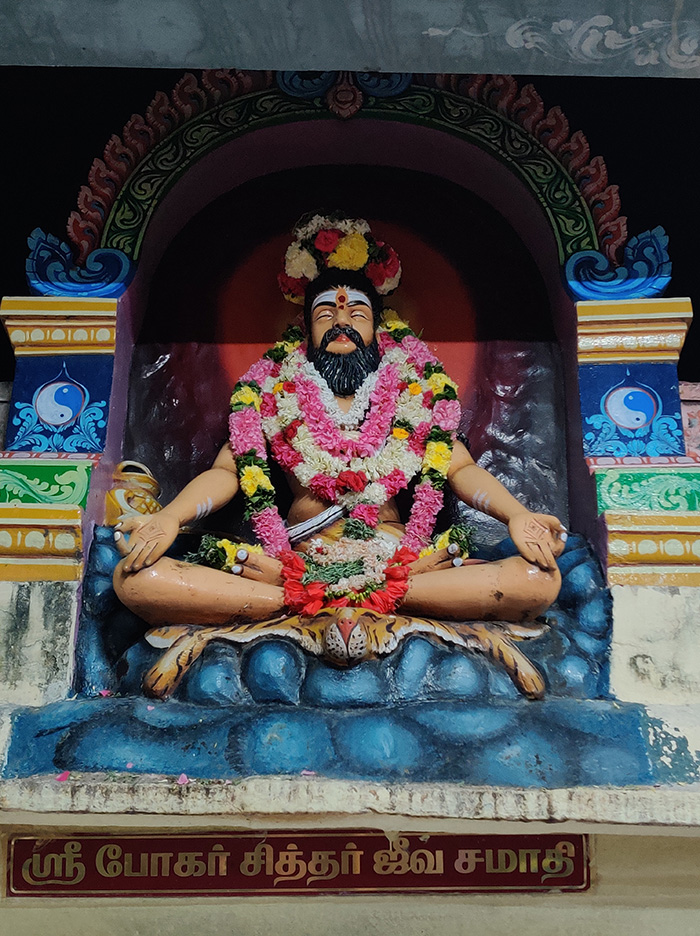
Life History
Sri Bhogar Siddha spent many years in China and crafted the deity of Lord Murugan at Palani with his extraordinary powers of alchemy. Sri Bhogar Siddhar was born in the Vaikasi (Tamil) month under the Bharani nakshatra (astronomical star). He attained mastery over Mantras when he was very young. His work is the Bhogar Vaithiyam (cures). He attained Samadhi at Palani. His Gurus were Agastya and also Kalanginatha.
Kalangi Nathar was born in Kasi (Benares). He attained the immortal state of swarupa samadhi at age 315 and then made China the centre of his teaching activities. He belonged to the ancient tradition of Nava (nine) Nath Masters tracing their tradition to Lord Adinath Shiva. There are nine significant shrines associated with this tradition, five of which are in the Himalaya Mountains: Amarnath (where Shiva first taught Kriya Yoga to his Shakti partner, Parvati Devi), Kedarnath, Badrinath (India), Kailasanath, (Tibet) and Pasupatinath (Nepal).
Meanwhile, Bhoganathar practiced Kundalini Yoga in four stages. Bhoganathar chose the Palani Malai (mountain) in southwestern Tamil Nadu as the site for intensive yogic practice (tapas) to reach the final stage. He attained swarupa samadhi at Palani, through the grace of Lord Murugan, or the eternal youth, ‘Kumara Swami.’ Thus, the Kumaraswami temple at Palani became the epicentre of his activities.
He visited many countries astrally and physically, and through transmigration leaving his body to enter into the body of another. In one of his songs, Bhoganathar claims to have flown to China at one point in a sort of airplane he built: he held discussions with Chinese Siddhas before returning to India (Kailasapathy, 1969, p. 197-211). His visit to South America has been confirmed by accounts left by the Muycas of Chile:
‘Bocha, who gave laws to Muycas, was a white, bearded man, wearing long robes. He regulated the calendar, established festivals, and vanished in time like others (other remarkable teachers who had come across the Pacific according to numerous legends of Incas, Aztecs, and Mayans).’ (Lal 1965, p. 20).
He convened a meeting of many Siddhas just before the beginning of the present Kali Yuga, in 3102 BC, to determine the best way for humanity to progress along the spiritual path during the coming period of darkness.
The Yoga of love and devotion, Bhakti Yoga, was chosen as being the best means. The Siddhas entrusted Bhoganathar with defining the rituals for the worship of their favorite deity, ‘Palani Andavar,’ the Lord (Murugan) of Palani.
Many rituals that centre around the bathing (abhishekam) of the idol of Palani Andavar with many substances, including panchaamirtam consisting of five fruits and honey, were developed by him and continue to be followed to this day. The idol had to be created from a substance that would last throughout Kali Yuga. The most resilient of known substances, granite, was known to wear and crack after thousands of such rituals. So Bhoganathar fashioned it out of nine secret herbal and chemical ingredients, nava pashanam, which made it harder than granite. Eight of the ingredients were combined in a mold of the idol. The ninth was added as a catalyst to solidify it.
In recent times, the scientists who attempted to determine the composition of a small sample of the material of the idol were startled to find that it immediately sublimated when heated. Thus, its composition remains a mystery to this date. Nevertheless, traces of the substance are contained in the ritual offerings in which it is bathed. When these are returned and consumed by the devotee, their spiritual progress is enhanced.
Kalangi Nathar decided to enter into samadhi in seclusion for 3,000 years. He summoned Bhoganathar telepathically to come from Tamil Nadu to China to take over his mission. Bhoganathar traveled by sea, following the trade route. In China, he was instructed by Kalangi Nathar in all aspects of the Siddha sciences. These included the preparation and use of the kaya kalpa herbal formulae to promote longevity. After Kalangi Nathar entered into a trance, Bhoganathar assumed his teaching mission to the Chinese. To facilitate this, he transmigrated his vital body into the physical body of a deceased Chinese man, and thereafter went by the name ‘Bo-Yang.’ ‘Bo’ is a derivation of the word ‘Bhogam’ which means bliss, material and spiritual.
This bliss, for which he was named ‘Bo-Yang’ is experienced when the Kundalini Shakti, the feminine primordial yin energy awakens, passes up to the crown of the head, the seat of Shiva, the masculine yang pole, in the Sahasrara chakra at the summit of the head and unites with it. The result of this integration of feminine and masculine parts of the being, or union (‘Yoga’) of Shakti and Shiva, Yin and Yang, is Satchidananda: Absolute Existence-Consciousness-Bliss.
Transformation of his physical body
Bhoganathar decided to overcome the limitations of the Chinese body, with its degenerative tendencies, and prolong its life through the use of the kaya kalpa (literally means body-immortal, the herbs that can make one immortal), herbs long enough for the effect of Kriya Kundalini Pranayama and related yogic techniques to bring swarupa samadhi.
In his poem Bhogar Jnana Sutra 8, verse number 4, he describes vividly what happened after carefully preparing a tablet using thirty-five different herbs:
With great care and patience, I made the (kaya kalpa) tablet and then swallowed it:
Not waiting for fools and skeptics who would not appreciate its hidden meaning and importance.
Steadily I lived in the land of the parangis (foreigners). For twelve thousand years, my fellow!
I lived for a long time and fed on the vital ojas (sublimated spiritual energy)
With the ojas vindhu I received the name, Bhogar:
The body developed the golden color of the pill:
Now I am living in a world of gold
(Based upon translation by Yogi S.A.A. Ramaiah, 1979, p. 40-42).
He chose three of his best disciples and his faithful dog and took them to the top of a mountain. After first offering a tablet to the dog, the dog immediately fell over dead. He next offered it to his leading disciple, Yu, who also immediately fell over dead. After offering it to the two remaining disciples, who by this time were extremely nervous, and who promptly hid their tablets rather than swallow them, Bhoganathar swallowed the remaining tablets and also fell over unconscious. Crying with grief, the two remaining disciples went down the mountain to get material to bury the bodies. When the disciples returned to the spot where the bodies had been left lying, all that was found was a note, in Bhoganathar’s handwriting, which said:
‘The kaya kalpa tablets are working. After awakening from their trance, I restored faithful Yu and the dog. You have missed your chance for immortality.‘
This kaya kalpa enabled Bhoganathar to transform the Chinese body over 12,000 years, during which time it developed a lustrous golden color. (The physiological transformation to the state of swarupa samadhi was completed only later at Palani in the final phases of Kriya Kundalini Yoga and related practices. Bhoganathar’s graphic description is recorded in the poem at the end of this chapter Initiation into Samadhi.)
In this poem Sutras of Wisdom, he sings prophetically of the taking up of the practice of pranayama in modern times by millions of persons who would otherwise have succumbed to drug abuse:
Will chant the unifying verse of the Vedanta.
Glory to the holy feet of Uma (the Divine Mother of the Universe. Shakti),
Will instruct you in the knowledge of the sciences, ranging from hypnotism to alchemy (kaya kalpa).
Without the need for pills or tablets, the great scientific art of pranayama breathing, will be taught and recognized
By millions of common people and chaste young women.
Verse no. I (based upon translation by Yogi S.A.A. Ramaiah, 1982, p. 40).
Becomes known as Lao-Tzu, founder of Taoism
After this incident with the Chinese disciples, Bo-Yang became known as Lao-Tzu, was accessible for nearly 200 years, and trained hundreds of Chinese disciples in Tantric Yoga practices, wherein semen and sexual energies are conserved and sublimated into spiritual energies. The advanced techniques he taught involve raising the energies from the muladhara chakra corresponding to the perineum up to the sahasrara chakra during sexual intercourse with a spiritually-minded partner; the sublimated energy, tejas, manifesting throughout all the cells of the body.
In the fifth century B.C., Confucius met Lao-Tzu Bo-Yang and afterward said of him:
‘I know a bird can fly, a fish can swim, and an animal can run. For that which runs, a net can be fashioned; for that which swims, a line can be strung. But the ascent of a Dragon on the wind into heaven is something which is beyond my knowledge. Today I have met Lao-Tzu, who is perhaps like a Dragon.‘
Among the Chinese, particularly the Taoists, the Dragon is the symbol of Kundalini Shakti, the primordial force.
At the end of his mission to China, about 400 BC, Bhoganathar, with his disciple Yu (whom he also gave the Indian name Pulipani) and other close disciples, left China by the land route. As recorded in the Taoist literature, at the request of the gatekeeper at the Han Ku mountain pass, Lao-Tzu crystallized his teachings in two books, the Tao Ching, with 37 verses, and the Te Ching, with 42 verses (MacKintosh, 1971).
In book two, he says, ‘Do good to him who has done you injury,’ which was also told by the contemporary Tamil Siddha, Tiruvalluvar, in his Tirukkural (Tiruvalluvar, 1968). The Taoist yoga traditions continue to seek physical immortality using techniques remarkably similar to those taught in Tamil Shiva Yoga Siddhanta.
Return to India
Along their way, Bhogar and his disciples visited several shrines in the Himalayas and Kamarupa, the famous Tantric Shakti shrine in Assam. He composed his most significant work of 700,000 verses near Mt. Kailasha with the blessings of Lord Shiva. It was later abridged to 7,000 verses and is known as Bhogar Sapta Kandam. He also visited Gaya, India, and Arabia. Upon returning to Tamil Nadu, he introduced the Chinese salts and chemistry called Cina-caram, and porcelain making. He submitted his 7,000 verse manuscript for evaluation to his guru Agastya at Courtrallam and an academy of Siddhas there. All of them endorsed it as great work.
Following this, many Siddhas, including Konkanavar, Karuvoorar, Nandeeswar, Kamala Muni, Satta Muni, Macchamuni, and Sundarandar, became his disciples to study the sciences of kaya kalpa and yoga. He eventually turned over his teaching mission to Pulipani.
Establishes shrine at Katirkamam and attains swarūpa samādhi
After performing tapas at Sathura Giri, and Shiva Gin, he went to Katirkamam in Sri Lanka to perform tapas and win the grace of Lord Murugan. Under inspiration from the Lord, he established the famous Yantra shrine, representing the 1,008 petalled lotus chakra, which blossomed in Bhogar there. He retired to Katirkamam, where Babaji Nagaraj met him around 211 AD. Finally, he went to Palani, where he attained swarupa samadhi.
Second Mission to China
Later, after the period of the Six Dynasties (220 to 590 AD), Bhoganathar returned with some Tamil disciples to China. He left his mission in Tamil Nadu with Pulipani, the Chinese Siddha. During the construction of the Brihitiswarar Shiva Temple in Tanjore, Tamil Nadu, around 900 AD. Bhoganathar advised its builders on raising the eighty-ton capstone to the top of the temple, more than 200 feet high. This was done through his disciple Karuvoorar and another Tamil disciple who acted as intermediaries and through messages tied to the legs of courier birds, like today’s homing pigeons.
At Bhogar’s suggestion, a gradient ramp five miles long was constructed, up which the stone was pulled to the top of the temple. This is considered one of the most remarkable engineering feats of all time. About this time, he also advised the King of Tanjore to build a small shrine dedicated to one of his greatest disciples, Karuvoorar, behind the Bhrihiteeswarar Shiva Temple.
Current Activities
While Bhoganathar is reported to have left the physical plane at Palani, he continues to work on the astral plane, inspiring his disciples and devotees. Even in rare instances, he transmigrates into another’s physical body for specific purposes.
Source: Babaji and the 18 Siddha Kriya Yoga Tradition, by M. Govindan (Kriya Yoga Publications, 1991), pp. 113-11a
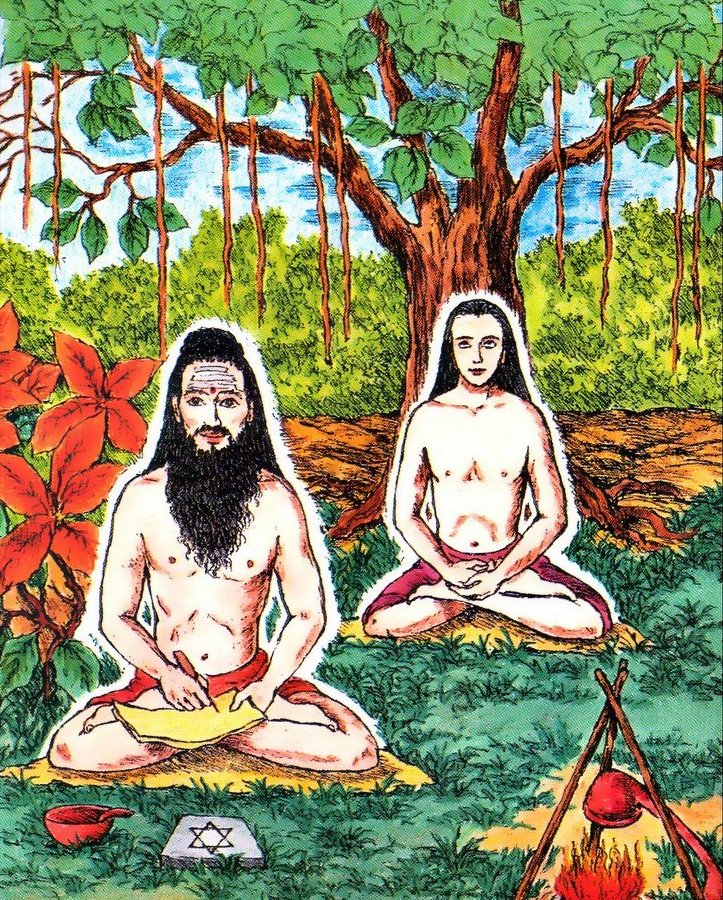
Tradition and Gurus
Bhogar was the ‘Jnana Guru’ of Babaji, and, in the poem ‘Bhogar Jnana Sagarama” (Bhogar’s Oceanic Life Story), he states that he himself was initiate into Jnana Yoga (Supreme Self-Knowledge) by great Siddha Kalangi Nathar.
In Bhogar’s Saptakanda, he reveals details of various medicinal preparations to his disciple Pullippani (so named as he is believed to have wandered in the forests atop a puli or tiger), and at every stage, he quotes his Guru as the authority. Also, Pulippani must have been a young man then, as he is often referred to as a balaka (a boy). Bhogar’s other disciples include: Konkanar Siddhar, Karuvorar Siddhar, Idaikadar Siddhar and Babaji (aka Mahavatar Babaji).
Sri Pulipani Siddhar was said to have been born in China. He is the person who helped Sri Bhogar Siddhar to collect the herbs required for the making of the Palani Murugan idol. His famous works are the Putlipani Jaalam as well as the Putlipani Vaidyam.
Siddha Tradition:
Tradition says that Lord Shiva was the first preceptor of Maharishi Nandi and the disciples of Nandi took up the traditions of the Siddha system and that Agastya was included in the list of his disciples. The Siddhar (Tamil: cittar, from Sanskrit siddha) in the Tamil tradition is a perfected individual who has attained spiritual powers called siddhi. Historically, Siddhar also refers to the people who were early age wandering adepts that dominated ancient Tamil teaching and philosophy. They were knowledgeable in science, technology, astronomy, literature, fine arts, music, drama, dance and provided solutions to ordinary people in their illness and advice for their future.
Typically, Siddhars were saints, doctors, alchemists, and mystics all in one. They wrote their findings in the form of poems in the Tamil language, on palm leaves which are collected and stored in what is known as the ‘Palm leaf manuscripts.’ These are still owned by some families in Tamil Nadu and handed down through the generations and kept in public institutions such as universities in India, Germany, Great Britain and the United States. In this way, Siddhars developed, among other branches of a vast knowledge system, what is now known as Siddha medicine, practiced mainly in Tamil Nadu as a type of traditional native medicine.
Tamil Siddhars were the first to develop pulse-reading to identify the origin of diseases. Eighteen saints are attributed numerous verses. They are: 1) Nandhi 2) Agasthiyar 3) Thirumoolar 4) Ramadevar 5) Bhogar 6) Konganar 7) Dhanvanthri 8) Vanmigar 9) Kamalamuni 10) Pathanjali 11) Sattaimunivar 12) Machamuni 13) Karuvurar 14) Pampatti 15) Korakkar 16) Kudambai 17) Sundarananthar 18) Idaikadar.

Teachings
Praying to Bhogar for 12 to 18 Wednesdays will provide a devotee the following blessings:
- Removal of impotence and blessing the couple with children
- Removal of hurdles in settling marriages
- Help to achieve a peaceful livelihood
- Blessing the devotees with land and house purchase or a profitable sale.
- Removal of Mangal dosha (issues in the birth chart due to the position of planet Mars).
Books authored by Bogar which also summarize the essence of his work to this world:
போகர் 7000 Bhogar 7000
போகர் ஜெனனசாகரம் Bhogar jananasaagaram
போகர் நிகண்டு 1200 Bhogar nigandu 1200
போகர் நிகண்டு கருக்கிடை Bhogar nigandu karukidai
போகர் நிகண்டு கையெடு Bhogar nigandu kaiyedu
போகர் வைத்திய காவியம் 1000 Bhogar vaithiya kaaviyam 1000
போகர் முனிவர் 700 Bhogar 700
போகர் சரக்கு வைப்பு 800 Bhogar sarakku vaippu 800
போகர் பஞ்சபட்சசாத்திரம் Bhogar panchapatchi sathiram
போகர் கற்பம் 300 Bhogar karpam 300
போகர் வர்மசூத்திரம் 100 Bhogar varma soothiram 100
போகர் மலைவாகடம் Bhogar malai vaagadam
போகர்– 12,000 Bhogar 12000
சப்தகாண்டம்– 7000 Bhogar saptha kaandam 7000
போகர் நிகண்டு– 1700 Bhogar nigandu 1700
போகர் வைத்தியம்– 1000 Bhogar vaithiyam 1000
போகர் சரக்குவைப்பு– 800 Bhogar sarakku vaippu 800
போகர் உபதேசம்– 150 Bhogar updesam 150
போகர் இரணவாகடம்– 100 Bhogar rana vaagadam 100
போகர் ஞானசாராம்சம்– 100 Bhogar gnanasaaraamsam 100
போகர் கற்பசூத்திரம்– 54 Bhogar karppa soothiram 54
போகர் வைத்தியசூத்திரம்– 77 Bhogar vaithiya soothiram 77
போகர் முப்புசூத்திரம்– 51 Bhogar muppu soothiram 51
போகர் ஞானசூத்திரம்– 37 Bhogar gnana soothiram 37
போகர் அட்டாங்கயோகம்– 24 Bhogar attanga yogam 24
போகர் பூஜாவிதி– 20 Bhogar poojavithi 20
Sacred Practices/Sadhana
Dr. T.N. Ganapathy (in his book, The Yoga of Siddha Bhoganathar, Volume 2) has rendered an excellent service to all lovers of spirituality and science. For the first time, the writings of Bhoganathar, the most outstanding scientist of the Siddha tradition, have been translated into English, and a helpful commentary on these profound and complex texts has been rendered. The volume contains poems that all lovers of Kundalini Yoga and Tantra will find inspiring.
By contemplating the poems, the chit-shakti or consciousness-energy of Bhoganathar may be absorbed, and the reader will enter a higher state of consciousness. This subtle process, referred to as swadhya or self-study, by Patanjali, in sutra 2.1 of his Yoga-Sutras, is an essential part of the sadhana of every student of Kriya Yoga and Tantra. While the poems have many layers of meaning, and such meanings can provide helpful guidance to the practitioner, this process of Self-realisation and transformation is most important in the contemplation of Siddha Bhoganathar’s works. For this reason, one should not read these poems as one would read an ordinary poem.
After invoking Boganathar by name and with reverence, one should first repeat the words of the poem in the original language of Tamil. By so doing, one may enter into the spirit of the work and communion with the author. Then one should review the meaning of each word, then the literal translation, then the summary translation, and finally the commentary. Afterward, one should meditate on the poem, and with practice, one may intuitively receive its hidden meaning.
Each poem is like a key, and like a key, it must be turned carefully in a lock to allow one to enter into a new space. By contemplating the poems in this way, one may enter into a new area, where the hidden meaning is revealed. Otherwise, the poem will remain as ink on paper, just as a key is a useless piece of metal if unused. The Siddhas, like Bhoganathar and Thirumoolar, would typically meditate for up to one year before writing a poem. The poem would serve as a point of departure for the disciple to contemplate, leading to all that the Siddha intended to communicate. In this way, the teachings of the Siddhas were revealed only to the most sincere persons, who were prepared to purify themselves by yogic sadhana, self-study, and devotion to the Lord.
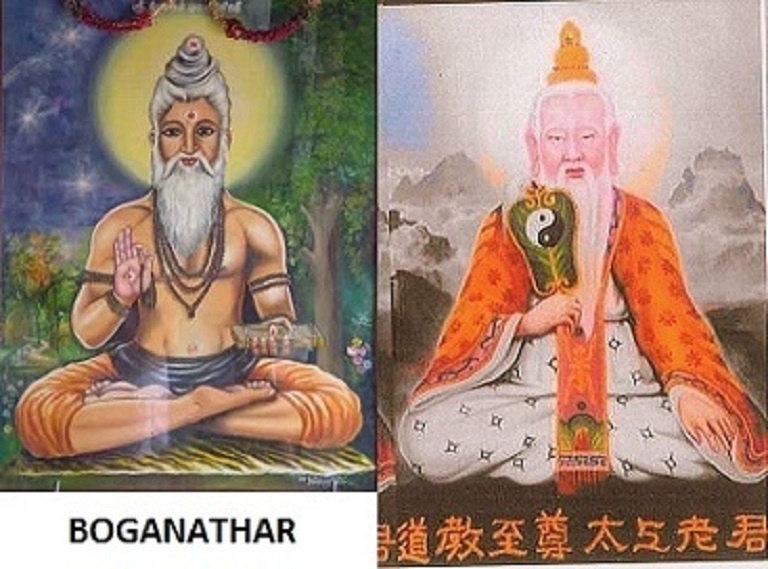
Contemporary Masters
Pulippani Siddhar (his prime disciple) and Mahavatar Babaji (Nagaraj).
His other disciples include Konkanavar, Karuvoorar, Nandeeswar, Kamala Muni, Satta Muni, Macchamuni, and Sundarandar
Brahmarishi Mohanji receives a message from Siddha Boganathar
‘Last year, one of my followers, a chartered accountant, visited a Master. This Master is deeply connected to the Siddha Tradition, which Babaji is also a part of. He’s seventy plus years old. When this Master saw this person, he asked, ‘Who’s your Guru?’ He said, ‘Mohanji.’ ‘Ah, I was waiting to talk to him. I have something to tell him.’ And he spoke about me and even about Mila, my daughter. Then the Master said that Babaji’s Guru, Bhoganathar, had been asking him to contact me. He said, ‘Bhoganathar wants to talk to him. I must speak to Mohanji.’ Normally, nobody has my number. My phone number is not available. So this chartered accountant contacted our people and said this person is asking for Mohanji’s phone number, can we give it? I said, ‘Give it to this person. It’s fine.’ He calls me and says, ‘I have important information for you. Bhoganathar wants to get back to you and remind you of your days with him.’ Then he gave me a mantra, which is a particular mantra. This is for me to connect to Bhoganathar. He said, ‘Forty-one days, you should chant this. After that, Bhoganathar will start talking to you.’ I could not sit down for 41 days, not even for 41 hours. So till now, it has not happened. I have kept the mantra. I do have the intention to sit down in some corner and chant, but schedules are not permitting so far. And then this Master told me we must meet; ‘I was also with you in that life.’ Of course, I could not get much time to meet him, but I met him in December last year. We had a very, very detailed discussion.
One question I asked him: ‘Tell me whether my understanding is true. Bhoganathar was clear that Babaji is an Avatar of Lord Muruga, son of Shiva. Was he clear?’ He said, ‘Yes, you’re absolutely right.’ He was an Avatar, and it was just like Sandipani Maharshi knowing that Lord Krishna was an Avatar. There was nothing to teach him – he already knew everything. But to keep the Tradition going, they attended with the Gurus and the normal path of learning. But they were all enlightened by birth. They were all Avatars. Just like Adi Shankara. When Adi Shankara, at the age of eight, went to Govindapada, Govindapada asked him, ‘Who are you?’ Then he replied, ‘Mano buddhyahankara chittani naham, Na cha shrotra jihve, na cha ghrana netre, Na cha vyoma bhumirna tejo na vayuhu, Chidananda rupah shivoham shivoham.‘ ‘I’m not the mind. I’m not the body. I’m not the organs of action. I’m not the organs of perception. I am Shiva.’ If you can talk like this at the age of eight, what will you learn from anybody?”
Holy Sites and Pilgrimages
Entrance of Bhogar Samadhi (in the pic on the left).
Siddhar Bhogar’s shrine, his Samadhi, is what remains today as a powerful example of the difference in lifestyle, the deep-rooted principles, and values that once governed the people of this soil. We all live in the same world, making use of probably the same things to evolve, yet the intensity of worship and the much-needed awareness to realise these methods of living are not half as strong now.
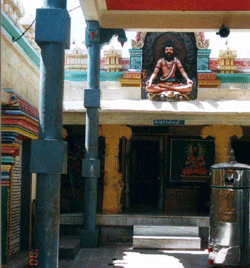
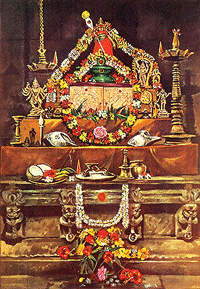
(Pic on the right) In the shrine is present the idol of Bhuvaneswari Amman and a Shiva lingam made of Maragatha stone (when you visit, ask the priest specifically to show them) worshipped by Bhogar. Below these deities is the underground passage where Bhogar went into samadhi. Now, this has been covered entirely without any indication of such a passage.
Bibliography
- Babaji and the 18 Siddha Kriya Yoga Tradition, by M. Govindan (Kriya Yoga Publications, 1991)
- THE YOGA OF SIDDHA BOGANATHAR, Volume 1 by T.N. Ganapathy
Volume 1 narrates the life of Bhogar and his teachings, Kundalini-Yoga, Astanga-Yoga, samadhi, and a translation and commentary of about seventy-five selected poems. By contemplating the verses, the conscious energy of Bhoganathar may be absorbed, and their hidden meaning may be revealed.
Bhoganathar was the Siddha guru of Kriya Babaji Nagaraj, the famed Himalayan master, of whom much has been written. Bhoganathar lived an extremely long life through the use of alchemical rejuvenation formulae and special breathing techniques. He traveled worldwide, chronicled Siddhas’ lives much older than himself, and provided his disciples an illumined path to Self-realisation and integral transformation of human nature into divinity. His extraordinary life provides a shining example of our human potential. This work provides a biography of Bhoganathar, as we can glean it from his writings alone, as well as introductory chapters on the Siddha tradition and Kundalini Yoga.
The work also provides a translation and commentary of about seventy-five selected poems, which serious students of all Kundalini Yoga and Tantra traditions will find illuminating. By meditating upon the verses, the reader will be able to draw much inspiration. Word-by-word translation is provided, with alternative meanings, a literal translation, and an interpretative translation, to balance the need for precision and understanding and facilitate a deeper meditative approach to the various layers of meaning of each verse.
'The Yoga traditions of India have been frequently neglected. This book, going back to ancient sources, is the first in a new series seeking to remedy this situation. Dr. Ganapathy and his team have labored hard to launch this series,and they do so with one of the most illustrious masters of Siddha Yoga - Bhogar. This volume is a great starting point for exploring the Tantric Yoga of the Siddhas.'
– Georg Feuerstein, Ph. D., author of "The Shambhala Encyclopedia of Yoga.”
‘The Yoga of Siddha Bhoganathar’ by T.N. Ganapathy, Ph. D., is the first in a series of publications produced by the Yoga Siddha Research Project sponsored by Babaji’s Kriya Yoga Order of Acharyas and Yoga Research and Education Center.
THE YOGA OF SIDDHA BOGANATHAR, Volume 2 by Dr. T.N. Ganapathy
From the foreword by M. Govindan Satchidananda:
‘The Yoga of Siddha Boganathar vol 2’ by Dr. T.N. Ganapathy takes us further into the little-known world of the Siddhas, adepts of Yoga, who for millennia have explored the furthest reaches of human potentiality and spiritual development. Bhoganathar was one of the greatest adepts of Yoga of all time and a great scientist. In our present scientific age, the study of his works is especially rewarding. For the past 500 years, our western civilisation has suffered from a schism between the rational, scientific view of life and the spiritual or religious view. This divide, created in the politically charged period of the Reformation, still haunts us. So, it is instructive to see in both the life of Bhoganathar, recorded in volume 1 and the writings on Yoga, in volume 2, how one great man married the two views.

